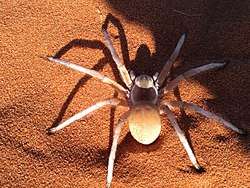Leucorchestris arenicola
| White Lady | |
|---|---|
 | |
| White Lady Spider in Namibia | |
| Scientific classification | |
| Kingdom: | Animalia |
| Phylum: | Arthropoda |
| Class: | Arachnida |
| Order: | Araneae |
| Family: | Sparassidae |
| Genus: | Leucorchestris |
| Species: | L. arenicola |
| Binomial name | |
| Leucorchestris arenicola Lawrence, 1962 | |
| Synonyms | |
| |
Leucorchestris arenicola (commonly called the Dancing White Lady Spider) is a huntsman spider found in the deserts of Namibia. It should not be confused with the similarly named Wheel spider from the same locale. [1][2] It relies on seismic vibrations for communication.[1] It taps its foremost legs on the sand to send messages to other white lady spiders.[1] Male white lady spiders will travel more than a mile in one night searching for a mate.[1] If they do find a mate, they must be extremely careful, for drumming the wrong message can be deadly.[1] The species was first described by Reginald Frederick Lawrence in 1962, who described all the species in the Leucorchestris genus.[2]
References
- 1 2 3 4 5 Henschel, Joh R. (2002). "Long-Distance Wandering and Mating by the Dancing White Lady Spider (Leucorchestris Arenicola) (Araneae, Sparassidae) Across Namib Dunes". Journal of Arachnology. 30 (2): 321–30. doi:10.1636/0161-8202(2002)030[0321:LDWAMB]2.0.CO;2.
- 1 2 Platnick, Norman I. (June 24, 2014). "Sparassidae". The World Spider Catalog, Version 15. American Museum of Natural History.
External links
- Nørgaard, Thomas; Henschel, Joh R.; Wehner, Rüdiger (2007). "Use of local cues in the night-time navigation of the wandering desert spider Leucorchestris arenicola (Araneae, Sparassidae)". Journal of Comparative Physiology A. 193 (2): 217–22. doi:10.1007/s00359-006-0178-6.
- Norgaard, T.; Nilsson, D.-E.; Henschel, J. R.; Garm, A.; Wehner, R. (2008). "Vision in the nocturnal wandering spider Leucorchestris arenicola (Araneae: Sparassidae)". Journal of Experimental Biology. 211 (5): 816–23. doi:10.1242/jeb.010546.
- Hallan, Joel 2006: Synopsis of the Described Araneae of the World. Texas A&M University Department of Entomology.
This article is issued from
Wikipedia.
The text is licensed under Creative Commons - Attribution - Sharealike.
Additional terms may apply for the media files.